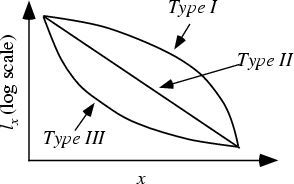Plotting  from a Life Expectancy table on a logarithmic scale versus
from a Life Expectancy table on a logarithmic scale versus  gives a curve known as a survivorship
curve. There are three general classes of survivorship curves, illustrated above.
gives a curve known as a survivorship
curve. There are three general classes of survivorship curves, illustrated above.
- 1. Type I curves are typical of populations in which most mortality occurs among the elderly (e.g., humans in
developed countries).
- 2. Type II curves occur when mortality is not dependent on age (e.g., many species of large birds and
fish). For an infinite type II population,
 , but this cannot hold for a finite population.
, but this cannot hold for a finite population.
- 3. Type III curves occur when juvenile mortality is extremely high (e.g., plant and animal species
producing many offspring of which few survive). In type III populations, it is often true that
 for small
for small  . In other words, life expectancy increases for individuals who survive their risky juvenile period.
. In other words, life expectancy increases for individuals who survive their risky juvenile period.
See also Life Expectancy
© 1996-9 Eric W. Weisstein
1999-05-26

![]() from a Life Expectancy table on a logarithmic scale versus
from a Life Expectancy table on a logarithmic scale versus ![]() gives a curve known as a survivorship
curve. There are three general classes of survivorship curves, illustrated above.
gives a curve known as a survivorship
curve. There are three general classes of survivorship curves, illustrated above.